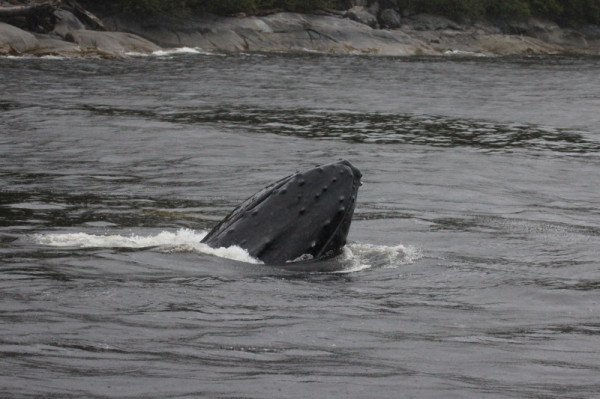Humpback Haven in Peril- Joint Review Panel Fails on Whales
Humpbacks are a delight to watch as they breach, drift by, or bubble net feed. I was lucky to visit a humpback haven on BC’s North Coast recently. WWF is helping Cetacealab, a research station on Gil Island, and the Gitga’at First Nation expand a hydrophone there to monitor underwater sound. Like thousands of others, I believe that oil tanker traffic just doesn’t belong here, and am struggling to understand how the Joint Review Panel for Enbridge Northern Gateway was able to conclude otherwise.

I’m amazed by the famous humpback song, the one that male Humpbacks across the entire Pacific Ocean share, a song that mysteriously changes from year to year. Janie Wray of Cetacealab says they remind her of “giant angels floating upside down, their fins splayed” as they hang in the deep fjords practicing their songs each fall.
The humpback populations around Douglas Channel, Wright Sound, Camaano Sound and Gil Island are, gradually recovering from commercial whaling.
Is humpback recovery in jeopardy from the Enbridge Northern Gateway Project? Experts think so.
Cetacealab (North Coast Cetacean Society) intervened in the Enbridge hearings and provided compelling evidence about the humpbacks, fins, and killer whales they study.Ocean underwater noise, just one of the threats humpbacks face, will significantly increase if the Enbridge project is constructed. WWF’s statement to the Panel noted increases in underwater noise as one of the many Project’s risks.
But the Joint Review Panel (JRP) apparently disagrees. Out of the hundreds of species that live on the pipeline and tanker route the Panel found only 2 species ,mountain caribou and grizzlies, faced potential significant cumulative adverse effects from the Project . In both cases the Panel found these impacts were “justified in the circumstances.”
The Panel said the project was not likely to result in significant adverse cumulative effects with respect to marine mammals.
Recent studies, too late to be admitted into evidence at the JRP hearings, are at odds with the Panel’s findings.
First, Fisheries and Oceans Canada’s recent Recovery Strategy for the North Pacific Humpback Whale , years in the making, maps four known critical habitats where humpbacks on BC’s North Coast congregate. Three are located on the proposed oil tanker routes. The Strategy identifies vessel traffic, toxic spills like oil spills, and a range of activities that cause acoustic disturbance as activities likely to destroy or degrade critical habitat. All these activities will proceed if the project is built.
Second, a recent peer reviewed scientific journal article on humpbacks by Erin Ashe, Janie Wray, Christopher R. Picard, and Rob Williams noted that potential oil tanker traffic through the relatively narrow Douglas Channel could threaten the humpbacks’ favourite “pit stop” because this bottleneck funnels and concentrates shipping traffic. The study warns that when animals are concentrated in small areas like Gil Island they are more vulnerable to catastrophic events like oil spills and ship strikes.
Though the Panel refused to consider the Recovery Strategy, and did not take note of that study, it did hear from:
– A biologist from the Raincoast Conservation Society who testified that Enbridge’s initial marine mammal technical study was so inadequate that: “We know as little about the importance of the proposed oil tanker route to cetaceans now as we did before this study was conducted.”
– DFO’s scientific experts who said that after reading Enbridge’s plan to protect whales, they were still unable to assess the risks of ship strikes to whales; and couldn’t determine if Enbridge’s ship strike mitigation plan would work.
– DFO scientists also said that it was not currently possible to determine acceptable underwater noise thresholds in the proposed tanker route area.
There is some uncertainty whether Enbridge’s proposed Marine Mammal Protection Plan will be legally binding. The Panel notes that “Northern Gateway would not be operating the vessels that call at the Kitimat Terminal, but Northern Gateway would require tankers transporting condensate and oil to and from the Kitimat Terminal to operate in an environmentally responsible manner.” And that “The National Energy Board has no regulatory authority over the enforcement of vessel speeds to prevent marine mammal strikes, except through oversight of the execution of Northern Gateway’s Tanker Acceptance Program and compliance with Northern Gateway’s marine voluntary commitments.”
As the US Oceans Commission says: “Because of their intelligence, visibility and frequent interactions with humans, marine mammals hold a special place in the minds of most people. Little wonder that, as a whole, marine mammals are afforded a higher level of protection than most other marine organisms.”
Little wonder, indeed.

